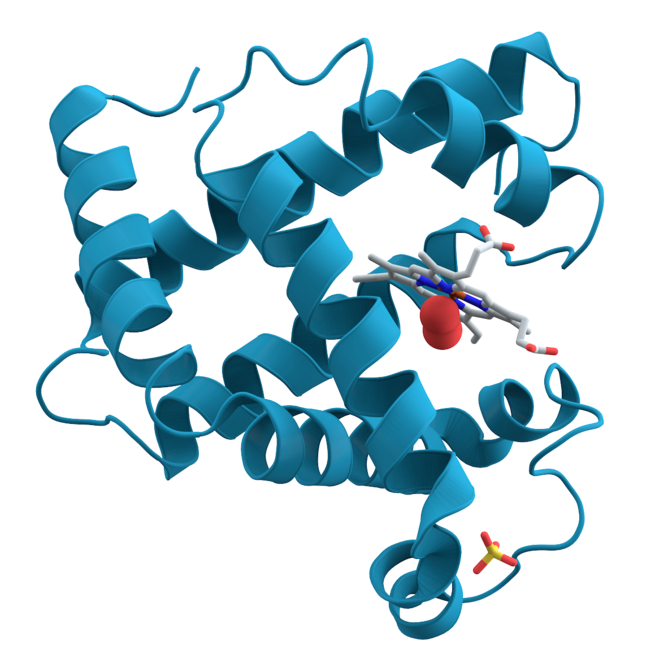
Main Difference
The main difference between Polypeptide and Protein is that the Polypeptide is a natural biological or artificially manufactured short chains of amino acid monomers linked by peptide (amide) bonds and Protein is a biological molecule consisting of chains of amino acid residues.
-
Polypeptide
Peptides (from Gr.: πεπτός, peptós “digested”; derived from πέσσειν, péssein “to digest”) are short chains of amino acid monomers linked by peptide (amide) bonds.
The covalent chemical bonds are formed when the carboxyl group of one amino acid reacts with the amino group of another. The shortest peptides are dipeptides, consisting of 2 amino acids joined by a single peptide bond, followed by tripeptides, tetrapeptides, etc. A polypeptide is a long, continuous, and unbranched peptide chain. Hence, peptides fall under the broad chemical classes of biological oligomers and polymers, alongside nucleic acids, oligosaccharides and polysaccharides, etc.
Peptides are distinguished from proteins on the basis of size, and as an arbitrary benchmark can be understood to contain approximately 50 or fewer amino acids. Proteins consist of one or more polypeptides arranged in a biologically functional way, often bound to ligands such as coenzymes and cofactors, or to another protein or other macromolecule (DNA, RNA, etc.), or to complex macromolecular assemblies. Finally, while aspects of the lab techniques applied to peptides versus polypeptides and proteins differ (e.g., the specifics of electrophoresis, chromatography, etc.), the size boundaries that distinguish peptides from polypeptides and proteins are not absolute: long peptides such as amyloid beta have been referred to as proteins, and smaller proteins like insulin have been considered peptides.
Amino acids that have been incorporated into peptides are termed “residues” due to the release of either a hydrogen ion from the amine end or a hydroxyl ion (OH−) from the carboxyl (COOH) end, or both, as a water molecule is released during formation of each amide bond. All peptides except cyclic peptides have an N-terminal and C-terminal residue at the end of the peptide (as shown for the tetrapeptide in the image).
-
Protein
Proteins () are large biomolecules, or macromolecules, consisting of one or more long chains of amino acid residues. Proteins perform a vast array of functions within organisms, including catalysing metabolic reactions, DNA replication, responding to stimuli, and transporting molecules from one location to another. Proteins differ from one another primarily in their sequence of amino acids, which is dictated by the nucleotide sequence of their genes, and which usually results in protein folding into a specific three-dimensional structure that determines its activity.
A linear chain of amino acid residues is called a polypeptide. A protein contains at least one long polypeptide. Short polypeptides, containing less than 20–30 residues, are rarely considered to be proteins and are commonly called peptides, or sometimes oligopeptides. The individual amino acid residues are bonded together by peptide bonds and adjacent amino acid residues. The sequence of amino acid residues in a protein is defined by the sequence of a gene, which is encoded in the genetic code. In general, the genetic code specifies 20 standard amino acids; however, in certain organisms the genetic code can include selenocysteine and—in certain archaea—pyrrolysine. Shortly after or even during synthesis, the residues in a protein are often chemically modified by post-translational modification, which alters the physical and chemical properties, folding, stability, activity, and ultimately, the function of the proteins. Sometimes proteins have non-peptide groups attached, which can be called prosthetic groups or cofactors. Proteins can also work together to achieve a particular function, and they often associate to form stable protein complexes.
Once formed, proteins only exist for a certain period and are then degraded and recycled by the cell’s machinery through the process of protein turnover. A protein’s lifespan is measured in terms of its half-life and covers a wide range. They can exist for minutes or years with an average lifespan of 1–2 days in mammalian cells. Abnormal or misfolded proteins are degraded more rapidly either due to being targeted for destruction or due to being unstable.
Like other biological macromolecules such as polysaccharides and nucleic acids, proteins are essential parts of organisms and participate in virtually every process within cells. Many proteins are enzymes that catalyse biochemical reactions and are vital to metabolism. Proteins also have structural or mechanical functions, such as actin and myosin in muscle and the proteins in the cytoskeleton, which form a system of scaffolding that maintains cell shape. Other proteins are important in cell signaling, immune responses, cell adhesion, and the cell cycle. In animals, proteins are needed in the diet to provide the essential amino acids that cannot be synthesized. Digestion breaks the proteins down for use in the metabolism.
Proteins may be purified from other cellular components using a variety of techniques such as ultracentrifugation, precipitation, electrophoresis, and chromatography; the advent of genetic engineering has made possible a number of methods to facilitate purification. Methods commonly used to study protein structure and function include immunohistochemistry, site-directed mutagenesis, X-ray crystallography, nuclear magnetic resonance and mass spectrometry.
-
Polypeptide (noun)
Any polymer of (same or different) amino acids joined via peptide bonds.
-
Polypeptide (noun)
Any such polymer that is not folded into a secondary structure of a protein.
-
Polypeptide (noun)
A small protein containing up to 100 amino acids; see also oligopeptide.
-
Protein (noun)
Any of numerous large, complex naturally-produced molecules composed of one or more long chains of amino acids, in which the amino acid groups are held together by peptide bonds.
-
Protein (noun)
One of three major classes of food or source of food energy (4 kcal/gram) abundant in animal-derived foods i.e. meat and some vegetables, such as legumes.
